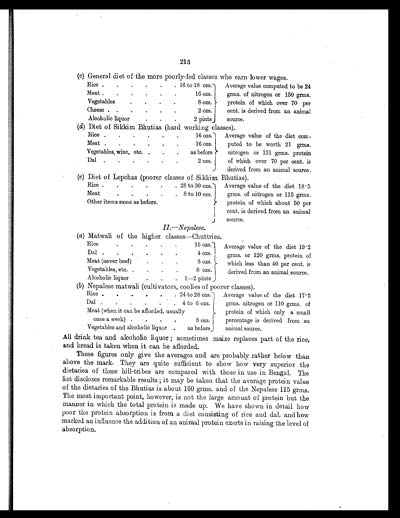Medicine - Institutions > Army health reports and medical documents > Scientific memoirs by officers of the Medical and Sanitary Departments of the Government of India > Number 37 - Investigations on Bengal jail dietaries > Part II > Relationship of food to physical development
(225) Page 215
Download files
Individual page:
Thumbnail gallery: Grid view | List view

215
(c) General diet of the more poorly-fed classes who earn lower wages.
| Rice | 16 to 18 ozs. | Average value computed to be 24 grms. of nitrogen or 150 grms. protein of which over 70 per cent. is derived from an animal source. |
| Meat | 16 ozs. | |
| Vegetables | 8 ozs. | |
| Cheese | 2 ozs. | |
| Alcoholic liquor | 2 pints |
(d) Diet of Sikkim Bhutias (hard working classes).
| Rice | 16 ozs. | Average value of the diet com- puted to be worth 21 grms. nitrogen or 131 grms. protein of which over 70 per cent. is derived from an animal source. |
|||||||
| Meat | 16 ozs. | ||||||||
| Vegetables, wine, etc. | as before | ||||||||
| Dal | 2 ozs. | ||||||||
(e) Diet of Lepchas (poorer classes of Sikkim Bhutias).
| Rice. | 28 to 30 ozs. | Average value of the diet 18. 5 grms. of nitrogen or 115 grms. protein of which about 50 per cent. is derived from an animal source. |
|||||
| Meat | 8 to 10 ozs. | ||||||
| Other items same as before. | |||||||
II.—Nepalese.
(a) Matwali of the higher classes—Chuttries.
| Rice | 16 ozs. | Average value of the diet 19. 2 grms. or 120 grms. protein of which less than 40 per cent. is derived from an animal source. |
|||||||
| Dal | 4 ozs. | ||||||||
| Meat (never beef) | 8 ozs. | ||||||||
| Vegetables, etc. | 8 ozs. | ||||||||
| Alcoholic liquor | 1—2 pints | ||||||||
(b) Nepalese matwali (cultivators, coolies of poorer classes).
| Rice | 24 to 28 ozs. | Average value of the diet 17.5 grms. nitrogen or 110 grms. of protein of which only a small percentage is derived from an animal source. |
| Dal | 4 to 6 ozs. | |
| Meat (when it can be afforded, usually once a week |
8 ozs. | |
| Vegetables and alcoholic liquor | as before |
All drink tea and alcoholic liquor; sometimes maize replaces part of the rice,
and bread is taken when it can be afforded.
These figures only give the averages and are probably rather below than
above the mark. They are quite sufficient to show how very superior the
dietaries of these hill-tribes are compared with those in use in Bengal. The
list discloses remarkable results; it may be taken that the average protein value
of the dietaries of the Bhutias is about 160 grms. and of the Nepalese 115 grms.
The most important point, however, is not the large amount of protein but the
manner in which the total protein is made up. We have shown in detail how
poor the protein absorption is from a diet consisting of rice and dal, and how
marked an influence the addition of an animal protein exerts in raising the level of
absorption.
Set display mode to: Large image | Zoom image | Transcription
Images and transcriptions on this page, including medium image downloads, may be used under the Creative Commons Attribution 4.0 International Licence unless otherwise stated. ![]()
| Permanent URL | https://digital.nls.uk/75033390 |
|---|




